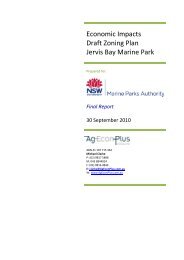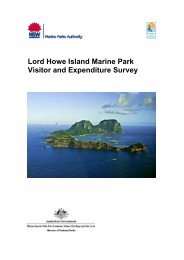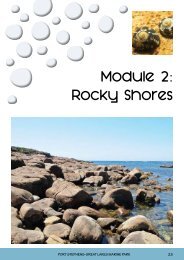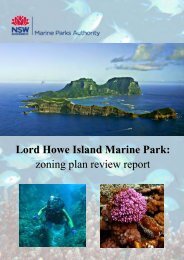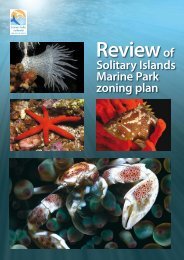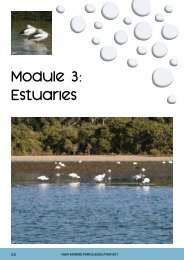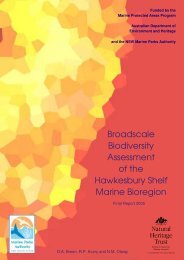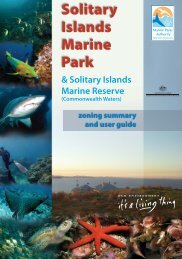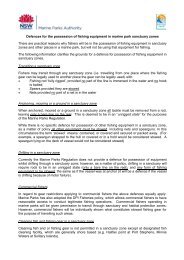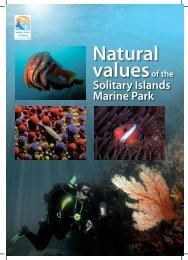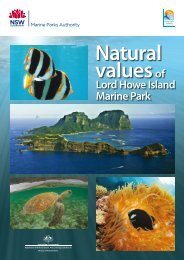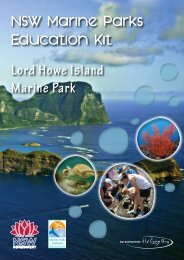Research Project Summaries 2002-2009 - Marine Parks Authority ...
Research Project Summaries 2002-2009 - Marine Parks Authority ...
Research Project Summaries 2002-2009 - Marine Parks Authority ...
You also want an ePaper? Increase the reach of your titles
YUMPU automatically turns print PDFs into web optimized ePapers that Google loves.
Since the completion of this monitoring program, the MPA has installed seagrassfriendlypublic moorings at Bindijine Beach and has introduced a policy of onlyconstructing seagrass-friendly moorings at the Callala Bay anchorage and othersensitive sites throughout the marine park.Acoustic behaviour and the effects of boat noise on bottlenose dolphinsPowerboats are a major source of disturbance to coastal cetaceans, althoughinteractions between powerboats and dolphins are not well understood. The surfacebehaviour and acoustic response of travelling dolphins to a powerboat were assessedbetween November 2001 and November 2003 in Jervis Bay (Lemon 2006). Dolphinbehaviour was monitored continuously from a research boat before, during and after apowerboat approached. Between these approaches, control observations were madeof the dolphins. They altered their surface behaviour as the powerboat approached andalso changed direction of travel. These changes were when the powerboat was morethan 100 m from the dolphins. There were no changes in dolphin whistle rates or theduration of echolocation click bouts when dolphins were approached by the powerboat.This was understandable, however, as travelling dolphins in Jervis Bay generally donot produce many vocalisations. These findings suggest that powerboats affect thesurface behaviour and direction of travel of bottlenose dolphins in Jervis Bay, but thatthis impact is not reflected in their acoustic behaviour.4.2.2 Pests and diseaseImpacts of invasive marine alga Caulerpa taxifoliaData on the effects of the invasive marine alga Caulerpa taxifolia on sedimentsubstrate structure are limited, particularly for invaded locations in temperate Australia.This is of particular concern for Jervis Bay, which although surrounded by C. taxiflorainfestations, is unaffected. Four NSW waterways were examined to:quantify the impacts of this alga on the sediment grain size and the distributionsof different grain sizesdetermine the average sediment grain sizes the alga inhabits identify the optimum sediment grain size for the alga to establish (Peart 2005).It appears that C. taxifolia can cause a reduction in average sediment grain size and anincrease in the proportion of silt in the sediment. C. taxifolia inhabits a wide variety ofsediments, ranging from silt to medium-grain sand. Of this range, it is most successfulin sediments ranging from 140 to above 280 microns. This indicates the species cansurvive in a variety of conditions and can also substantially alter the sediment substratestructure over large areas of seabed. The effects of such changes on organisms areunknown, although potentially very significant.The MPA, in collaboration with the Shoalhaven City Council and the Southern RiversCatchment Management <strong>Authority</strong>, identified a range of soft sediment habitat locationsthat might be suitable for invasion of C. taxifolia. These were in Jervis Bay and inestuaries of the marine park, as well as adjacent waterways. New areas of C. taxifoliawere found in estuaries adjacent to the marine park, but no sightings were recorded inthe marine park. To help maintain this infestation-free status, an introduced marinepest strategy is being developed.Solitary Island and Jervis Bay <strong>Marine</strong> <strong>Parks</strong> <strong>Research</strong> <strong>Project</strong>s <strong>Summaries</strong> <strong>2002</strong>–<strong>2009</strong> 35



